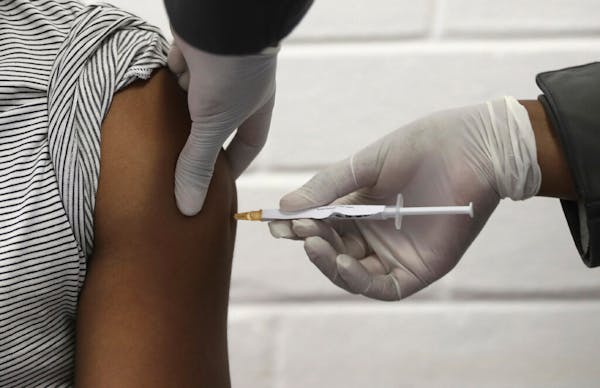Erika Jagiella wakes up at night fretting about lesson plans she needs to create and deliver to kids in person and in a socially distanced way. Then, she remembers: There's online coursework to craft, too.
The crush of daily workload demands has been so great that Jagiella, a special education teacher for the White Bear Lake Area Schools, only recently finished rewriting the individual education plans required for her students. "My brain just can't slow down," she said. "I'm constantly thinking about my students, my work and the work ahead of me."
Teachers across Minnesota are frazzled trying to navigate pandemic-related combinations of in-person and online instruction — so much so that nearly one-third responding to a recent statewide survey said they were thinking of quitting. Many work extra hours on nights and weekends as they juggle students in multiple formats, forcing union leaders to press for relief from school and district administrators.
The hybrid model of learning is designed to give students and teachers at least a couple of days of face-to-face time each week and to give students access to in-person supports around mental health and other concerns. Still, there is the distance learning component to contend with, too, and in the Anoka-Hennepin School District, for example, that has pushed elementary teachers to the "breaking point," according to a petition signed by more than 1,350 people.
Teachers presented the petition to school board members on Sept. 28, imploring district leaders to let them focus on one set of students at a time. Looking in via Zoom were 183 district teachers.
Jim Skelly, a district spokesman, said last week that the state's largest district now is providing recorded video lessons in math and reading for elementary teachers to use through the end of the first trimester.
School leaders are aware of the concerns and have worked with staff members in their buildings since the start of the year, he said, adding, "Work is continuing on strategies to reduce workload and stress for teachers as the school year progresses."
This month, Education Minnesota, the state's teachers union, released results of a survey showing 81% being "stressed" over hybrid instruction and 28% "thinking about quitting or retiring" as a result. The survey drew responses from about 1 in 5 union members, meaning it could've been skewed by those most passionate about the changes.
But educators from Champlin Park to Osseo to Elk River to White Bear Lake have gone public with their frustrations, perhaps most notably at a recent news conference headlined by Randi Weingarten, president of the American Federation of Teachers.
"Unfortunately, we've heard many of these stories," Weingarten said of the litany of concerns. "What you're seeing in this country is a patchwork failure."
At Lakeaires Elementary in White Bear Lake, Beth Clymer, a fourth-grade teacher, said she has seen colleagues crying, and she has cried, too, mostly at home, where she works after-hours to assemble materials for her distance learners, taking attention away from her two young sons.
The at-home work falls outside her contract hours, and the district has agreed to pay teachers for 32 hours of that "prep time" through Nov. 13. Teachers are grateful, Clymer said, but can burn through the allotment quickly. In 2½ weeks, she said, she racked up 42½ prep time hours.
"I can't see spending an extra 15 hours per week from here until May trying to make this work," said Clymer, now in her 19th year of teaching. "I don't think I'd hesitate," she said, to take a less stressful job with comparable pay.
Her wish, in the meantime, is that the district would deploy a teacher at Lakeaires to work exclusively with distance learners.
Marisa Vette, a district spokeswoman, said White Bear Lake has seen enough students select distance learning at some grade levels and in some buildings to allow it to assign teachers to that role. But most grades in most buildings do not have enough kids to make it feasible, she said.
District leaders are listening to families and staff members and weighing changes, Vette said. The school board is expected on Nov. 9 to discuss a memorandum of understanding with teachers that she says "speaks to safety measures, changes to the duty day and access to time off and leave during the school year."
Like the Anoka-Hennepin district, White Bear Lake also plans to move secondary students back to distance learning only as COVID-19 cases rise in their counties. Elementary students will remain in the hybrid format.
The hybrid model does have some high-profile support: At Echo Park Elementary in Burnsville, Qorsho Hassan, the state's current teacher of the year, said recently she appreciated the smaller class sizes. Students can flourish when individual needs are met, she said.
St. Paul's general-education students are working online only, and for the middle school and high school kids, the shift to a hybrid model would not come until early next year, at the earliest.
Megan Olivia Hall, who teaches secondary life sciences at Open World Learning Community on the West Side, has found distance learning to be challenging enough and prefers to stay in that mode alone for now.
"I can't simultaneously run a high-quality distance learning classroom and a high-quality face-to-face classroom, even if only half of my students are attending in person at one time," Hall wrote in an e-mail. "Like many teachers, I am committed to doing my job well, and it would break my heart to deliver less than what my students deserve."
Hall, too, is a former state teacher of the year, having captured the honor in 2013.
Teachers are superheroes, she said, but two jobs at once is just too much.
Anthony Lonetree • 612-673-4109

Trail section at one of Minnesota's most iconic spots closing for rehab

Will 'shotgun only' zone for deer in southern Minnesota be abolished?

Four Minnesotans catch salmonella in outbreak linked to basil sold at Trader Joe's

